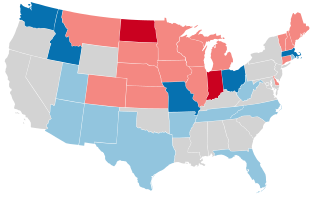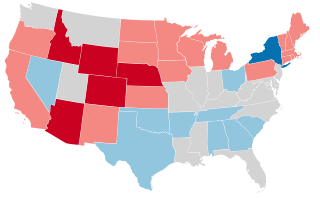| ||||||||||||||||||||||
2 governorships | ||||||||||||||||||||||
|---|---|---|---|---|---|---|---|---|---|---|---|---|---|---|---|---|---|---|---|---|---|---|
| ||||||||||||||||||||||
 Democratic holds | ||||||||||||||||||||||
United States gubernatorial elections were held on 7 November 1961, in two states, New Jersey and Virginia. The elections did not result in any change of balance between Republican and Democratic seats.
| ||||||||||||||||||||||
2 governorships | ||||||||||||||||||||||
|---|---|---|---|---|---|---|---|---|---|---|---|---|---|---|---|---|---|---|---|---|---|---|
| ||||||||||||||||||||||
 Democratic holds | ||||||||||||||||||||||
United States gubernatorial elections were held on 7 November 1961, in two states, New Jersey and Virginia. The elections did not result in any change of balance between Republican and Democratic seats.
| State | Incumbent | Party | Status | Opposing candidates |
|---|---|---|---|---|
| New Jersey | Robert B. Meyner | Democratic | Term-limited, Democratic victory | Richard J. Hughes (Democratic) 50.37% James P. Mitchell (Republican) 48.74% Reinhardt V. Metzger (Conservative) 0.27% Henry B. Krajewski (Veterans Bonus Now) 0.18% Edward J. Lueddeke (Prosperity with Liberty) 0.12% G. George Addonizio (Independent) 0.11% Albert Ronis (Socialist Labor) 0.10% Daniel Petrino (State Soldiers Bonus) 0.07% Ruth F. Shiminsky (Socialist Workers) 0.05% [1] |
| Virginia | J. Lindsay Almond | Democratic | Term-limited, Democratic victory | Albertis Harrison (Democratic) 63.85% H. Clyde Pearson (Republican) 36.14% Write-ins 0.02% [2] |

The 1960 United States Senate elections coincided with the election of John F. Kennedy as president on November 8, 1960. The 33 seats of Class 2 were contested in regular elections. A special election was also held on June 28, 1960, for a mid-term vacancy in North Dakota where Democrats flipped a seat to expand their majority to 66–34. As Majority Leader Lyndon Johnson was elected Vice President, Mike Mansfield became the new majority leader.

The 1800–01 United States House of Representatives elections were held on various dates in various states between April 29, 1800 and August 1, 1801. Each state set its own date for its elections to the House of Representatives before the first session of the 7th United States Congress convened on December 7, 1801. They were held at the same time as the 1800 presidential election, in which Vice President Thomas Jefferson, a Democratic Republican, defeated incumbent President John Adams, a Federalist. Elections were held for all 105 seats, representing 15 states.

The 1962 California gubernatorial election was held on November 6, 1962. The Democratic incumbent, Pat Brown, ran for re-election against former U.S. vice president and 1960 Republican presidential nominee Richard Nixon. In his concession speech the following morning, Nixon accused the media of favoring his opponent Brown, stating that it was his "last press conference" and "You won't have Nixon to kick around any more." Six years later, Nixon was elected President of the United States, and ten years later to the day, he was re-elected in a landslide.

Virginia's fourth congressional district is a United States congressional district in the state of Virginia, taking in most of the area between Richmond and the North Carolina state line. It covers all or part of the counties of Brunswick, Charles City, Chesterfield, Dinwiddie, Greensville, Henrico, Prince George, Southampton, Surry, and Sussex, and all or part of the independent cities of Colonial Heights, Emporia, Hopewell, Petersburg, and Richmond. The district is currently represented by Democrat Jennifer McClellan, who was elected to the seat after she defeated Republican Leon Benjamin in the February 21, 2023 special election, caused by the death of incumbent Donald McEachin (D) on November 28, 2022.

The 1972 United States Senate election in Texas was held on November 7, 1972. Incumbent Republican U.S. Senator John Tower won re-election to a third term.

United States gubernatorial elections were held 6 November 1962 in 35 states, concurrent with the House and Senate elections.

United States gubernatorial elections were held on 8 November 1960, in 27 states. The elections were concurrent with the House elections, the Senate elections and the presidential election.

United States gubernatorial elections were held in 1958, in 34 states, concurrent with the House and Senate elections, on November 4, 1958. Alaska held its first gubernatorial election on achieving statehood.

United States gubernatorial elections were held in 1959, in four states. Kentucky, Louisiana and Mississippi hold their gubernatorial elections in odd numbered years, every 4 years, preceding the United States presidential election year. Hawaii held its first gubernatorial election on achieving statehood.

The 1962 United States Senate special election in New Hampshire took place on November 6, 1962, to elect a U.S. Senator to complete the unexpired term of Senator Styles Bridges, who died on November 26, 1961. New Hampshire Attorney General Maurice J. Murphy Jr. was appointed on December 7, 1961 by Governor Wesley Powell to fill the vacancy until a special election could be held.

United States gubernatorial elections were held in 1956, in 30 states, concurrent with the House, Senate elections and the presidential election, on November 6, 1956. The special election in Oregon was due to the death of incumbent governor Paul L. Patterson on January 31.

United States gubernatorial elections were held in 1954, in 34 states, concurrent with the House and Senate elections, on November 2, 1954. The special election in Florida was due to the death of incumbent governor Daniel T. McCarty on September 28, 1953.

United States gubernatorial elections were held in 1944, in 32 states, concurrent with the House, Senate elections and presidential election, on November 7, 1944.

United States gubernatorial elections were held in 1942, in 33 states, concurrent with the House and Senate elections, on November 3, 1942.

United States gubernatorial elections were held in 1936, in 34 states, concurrent with the House, Senate elections and presidential election, on November 3, 1936.

United States gubernatorial elections were held in 1926, in 33 states, concurrent with the House and Senate elections, on November 2, 1926.

United States gubernatorial elections were held in 1924, in 36 states, concurrent with the House, Senate elections and presidential election, on November 4, 1924.

United States gubernatorial elections were held in 1922, in 33 states, concurrent with the House and Senate elections, on November 7, 1922.

United States gubernatorial elections were held in 1918, in 32 states, concurrent with the House and Senate elections, on November 5, 1918.

United States gubernatorial elections were held in 1916, in 36 states, concurrent with the House, Senate elections and presidential election, on November 7, 1916.